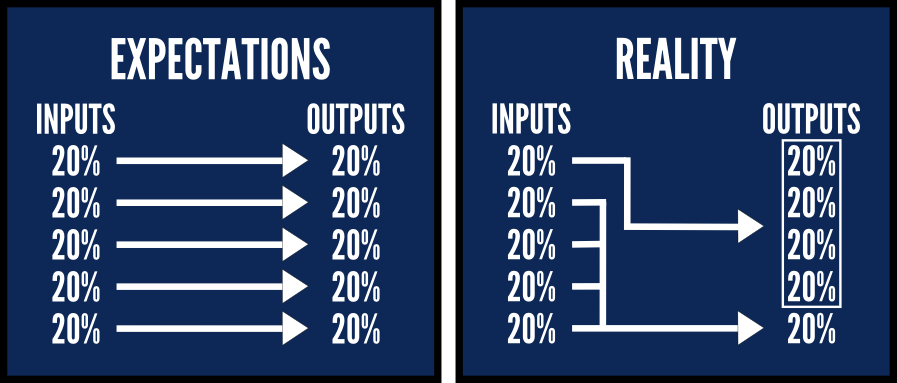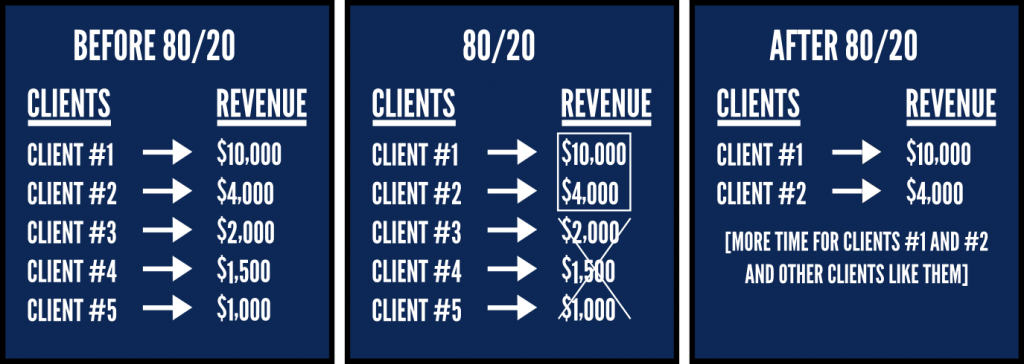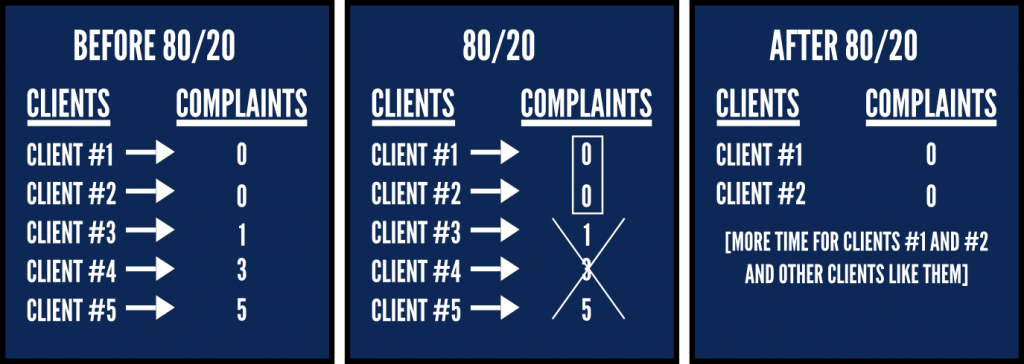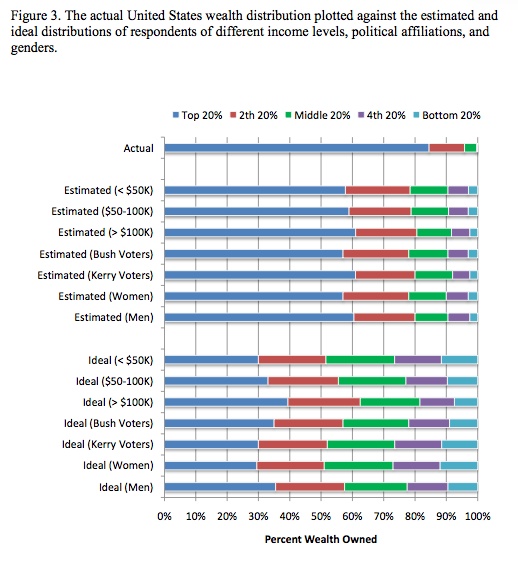80/20 In A Nutshell
Table of Contents
You don’t need to do everything. You only need to do the things that get results.
You can either think that’s unfair or you can use it to your advantage. If you’re reading this, you’re one of the smart people who will choose to harness the energy of this principle rather than fight against it.
Here’s how you can do just that to optimize everything you do from the get-go.
How 80/20 Works
For most events, roughly 80% of the effects come from 20% of the causes. This number can change – sometimes it’s 70/30 and sometimes it’s 90/10. But whatever the ratio, the point is that a small number of causes have a disproportionately large effect on the outcome.
From income to clients to blog posts to travel to fitness to relationships, you’ll find that the 80/20 rule works everywhere.
But let’s back up a bit. What is the 80/20 principle and what does it even mean?
The Essential Rule:
20% of the inputs drive 80% of the outputs.
This rule originated in Richard Koch’s book, The 80/20 Principle. This book is a solid read and is definitely worth going through.
Interestingly enough, if you pick up Koch’s book, you’ll notice that, 25 pages in, he mentions that you can get the most important knowledge in every book by following a three-step process. Like a good student, I followed his instructions – I read the start and the end of the book, skimmed the rest, and then read the start and the end again. If the author is going to tell you how to read books, you should listen!
80/20: A Visual Example
Some Practical Examples Of 80/20
Language
Most languages have close to a million words (if not more).
Most people only use a few hundred of those words in a day.
If you want to learn a language, you don’t need to memorize the dictionary. You just need to learn the words that are used most often. That’s less than a few thousand words.
You could spend day and night learning the Spanish words for the minutia of biology and the entirety of the language, but unless you urgently need to speak about mitochondria, the words you’ve learned probably won’t be of much use to you.
If you’re not interested in explaining mitochondria, you can master the basics much, much faster. That’s how someone like Benny manages to learn a language in three months. He doesn’t focus on being perfect. He just focuses on speaking and doesn’t worry about looking stupid.
Diet
If you change 20% of the foods you eat, you’ll see absolutely massive results, particularly when you’re just starting to improve your diet for the first time.
If you’re eating paleo and you cut out sugar and grains, you’re not going to have to worry about whether or not a legume is strictly paleo. It may be important but it’s not the most important thing, so you don’t have to worry about it. Simply choosing to stop eating junk and to start eating real food is going to give you bigger results right off the bat than if you debated whether or not to eat beans.
I’ve talked about this in multiple places, but cutting out grains and dairy will get you 80% of the way there. Everything after that is simply tweaking.
If you’re frustrated at not seeing results when it comes to losing weight, stop thinking you need to overhaul everything. Just change the few things that are going to make a huge difference, and use that change to get the momentum to make more changes further down the road.
Fitness
If you want to start changing your fitness habits, you don’t need a complicated program. You can make a ton of progress through body-weight movements and sprints.
This is what the entire No Excuse Workout is based on. You don’t need a mega-gym and a personal trainer to get into shape. You just need to get started, to focus on a few movements, and to make those movements into a habit.
Business
Back when I worked in an agency, there was this mindset that you could never ever lose a client. Ever.
There was no real reason for this belief. It was just seen as “bad” to “lose” a client. Even if that client sucked. And some clients did suck. Badly.
To give an example, we had one client who paid us almost nothing and who would call to complain almost daily. Despite the fact that we doubled their conversions (and revenue), and cut their costs in half, they still weren’t happy. They didn’t care about results because they wanted control.
With some clients there’s no reasoning.
Hint: It’s always the clients who pay you the least who want the most from you.
Unfortunately, wanting to “keep every client” is a terrible mindset to have when running an agency. But, because this mindset existed throughout the agency, we were losing ~$20,000/month. But money wasn’t too much of a concern (due to the organization’s structure and the investors behind it), so no one worried about it too much.
However, I’m allergic to poor functioning businesses, so I took to Excel, and, in twenty minutes, laid out how we could cut half of our “problem” clients who were bringing in less than $1,000/month. I also outlined how we could double down on our existing (headache-free) clients who loved us, and make more money with fewer headaches (without getting rid of any employees), and actually turn a profit.
I got a “Hmm … That’s interesting” before I decided to leave. I still don’t know what they decided to do with that spreadsheet.
This also works for a ton of other business scenarios. Here are a few examples:
- If you run a blog, you’ll find that 20% of your posts generate 80% of the traffic.
- If you sell products, you’ll find that 20% of your products produce 80% of your revenue.
- If you look at your expenses, you’ll find 20% of your bills represent 80% of your expenses.
80/20, 80/20, 80/20.
Income Earning & Wealth
Warning: Controversy ahead!
Below you’ll see a chart of current “income inequality” charted against “estimated” and “ideal” levels for different demographics. At first glance, these charts look terrible. But if you really look at what they show, it’s simply the 80/20 rule at work, to the nth degree. Check it out.
The actual distribution clocks in with the top 20% owning about 84% of the total wealth. To people who don’t understand the 80/20 rule, this looks grossly unfair – everything should be distributed much more fairly! (Not coincidentally, almost every other “estimate” and “ideal” skews that way). However, if you’re familiar with 80/20 in everyday life, it won’t surprise you very much at all that the “actual” wealth distribution follows the 80/20 rule almost exactly.
Please note: I’m not arguing that this is a good or a bad thing. I’m simply saying it is. 80/20 is a reality that you can choose to either ignore or understand and use to your advantage. If you’re smart, you’ll pay attention to it.
80/20 is everywhere. Use it if you dare …
Why You’re Scared To Actually Use 80/20
I was raised to have the hardworking Midwestern mindset. Work hard and don’t leave until the job is done. Do it right every single time.
That’s great advice. It creates integrity and a sense of pride in your work. It’s solid advice that most people could apply to their life and work.
It can also be a foolish waste of time if you mindlessly apply it across the board to anything and everything you have to do.
Here’s the truth: You don’t have to be perfect. Your work doesn’t have to be perfect. In fact, it’s often not going to be perfect. So instead of chasing the impossible standard of perfection, focus on getting to “good enough” to go to the next step.
If you’re not quite sure how to feel about this, your inner perfectionist is probably crying foul.
I’ve got some news for you: You need to make him disappear.
He needs to go away, for good. You need to kill him off. Use your bare hands if you have to. It won’t be pretty but it’s necessary. He seems harmless, well-meaning even, but he’s holding you back from being as effective as you could be.
Putting 80/20 Into Action
If you’re tired of theory, here are some practical things you can do to implement 80/20 today.
Budget
Look at your budget. Use Mint to start analyzing your purchases. Which categories cause the biggest expenses? Figure out which big expense you can cut. Pick something like cable. Cutting out cable would save you $100/month – probably the same amount as cutting something small that you have all the time, like your daily cup of coffee – and would give you more time to create something worthwhile at the same time. Double win.
Revenue
Analyze your various revenue streams and the effort involved in each. The chances are that you’ve got one cash cow or bigger revenue stream which takes the least work/is the most fun/is the easiest to run. Get rid of the other obligations that aren’t generating ROI on the same scale, and focus more on those streams providing disproportional results. (This is what I did when I cut off a lot of low budget client work.)
Diet
Don’t overhaul your whole diet. Don’t go on a “cleanse” or spend hundreds of dollars on juicing. Just cut out grains and dairy for four weeks. See what happens.
Fitness
Don’t get a gym membership. Don’t spend three hours a day on the treadmill. Spend twenty minutes a day doing a four-week program or an eight-week program of body-weight movements and sprints. Combine this with your new diet, and watch what happens.
Language
Stop trying to memorize the dictionary, and learn 200 words in another language. Buy a ticket to another country for a week and just start speaking to people. Watch yourself become more fluent in that language in seven days than your friends who spent months with their heads in a textbook.
Websites & Marketing
Instead of focusing on every marketing channel imaginable, look at your stats for the last 90 days and find out where the majority of your traffic is coming from. Double down on those traffic sources and forget everything else. Do this for 90 more days and then watch what happens.
Exceptions To The Rule: When The 20% Is Needed
Of course, the 80/20 rule isn’t guaranteed to work 100% of the time (it’s called the 80/20 rule after all). If you find yourself in any of the following situations, please ignore all the above advice:
- You’re building a rocket.
- You’re a surgeon operating on somebody’s brain, heart, or other vital organs.
- You’re translating sign language at an international leader’s funeral. In this case, you should know more than 20% of sign language, unlike this guy:
If one of those situations applies to you, good for you. Otherwise, get over yourself, focus on the 20% that matters, and get stuff done
Note: This is not a political discussion. If you leave disrespectful, incendiary or stupid comments, it will be deleted.
Further Reading On The 80/20 Principle
- The 80/20 Principle
- The 80/20 Principle & 92 Other Powerful Laws of Nature
- 80/20 Perry Marshall
- http://en.wikipedia.org/wiki/Pareto_principle
Other Productivity Blogs at IMPOSSIBLE
Photo credit: Joe Shlabotnik, Ron Reiring, Harris Walker, Daily Star









Great post… I’ve just started reading ‘4 hour work week’, and this post summarises things really nicely and clearly. I just need to take some time to sit down and apply it to my own work life which has begun to get a little out of control in the last few months since setting up my own business- things are taking off and now it’s time to focus!
That was probably the most easily digestible run-down of the Pareto Principle that I’ve ever read. I especially appreciated the 20-20-20-20-20 charts.
Thanks!
will implement this comcept in my work; its a fresh start for me and greatful that I found your blog. Thanks
Great article, 80/20 clear to the point, just received perry’s book ….its on my 20% agenda now!
80/20 70/30 90/10 or thereabouts. The exact figures do not matter much, but the idea that most of your results come from a discrete fraction of the work or the people or the resource.
This is one of the best explanations of this idea I have seen, Signor Pareto would be proud. Sometimes it takes more courage to stop doing something rather than to continue, and if courage is called for, that sounds pretty good to me.
I think the 80/20 rule is disliked by many people because it is not easy to understand why it is like that. What kind of blogger wants to hear that out of all the time they spend writing, only 20% of those posts are really going to matter. It could easily drive out ambition of the writer.
I think that it is important just to acknowledge the power of the 80/20 rule, we don’t have to know how or why it works, just accept that it does. And next time you have to explain to someone you don’t want to have them as a client anymore, we can tell them to blame Pareto not us.
Good Work!
In depth and easy to understand. I thought this was really well written. The best thing is with effort, research, and continuing to tweek and try new things, anyone can benefit from this principle both in their personal lives and their businesses.
Great post Joel! I learned a lot with this article. This is especially helpful for new bloggers like me (3 weeks in).
Thank you for sharing.
Powerful and refreshing. I will apply.
Interesting concept. I will start spending more time with my most productive client and start dropping the problematic ones.
Thanks
The 80/20 principle is very well summarized here and is in fact very helpful.